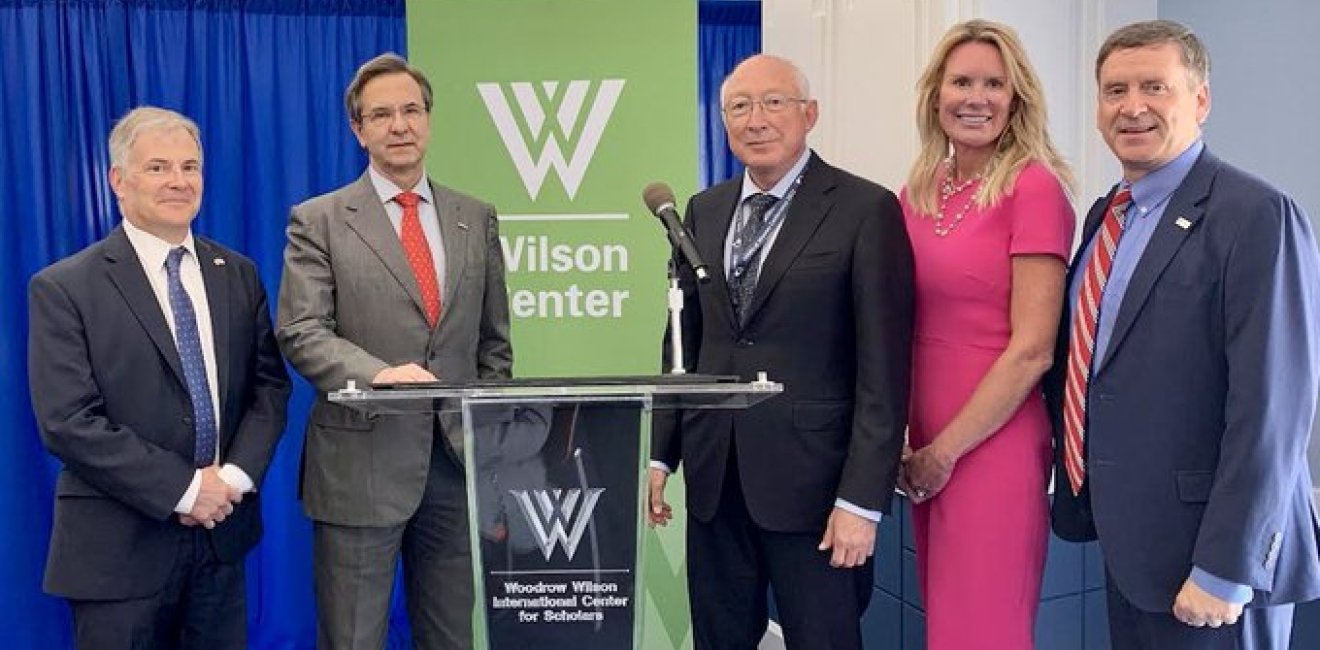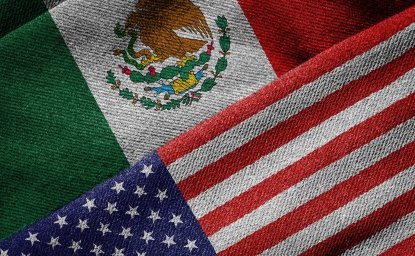American poet Robert Penn Warren wrote: "History cannot give us a program for the future, but it can give us a fuller understanding of ourselves, and of our common humanity, so that we can better face the future."
He makes us understand why the history of the border can help us find the history of the interdependence between the U.S. and Mexico.
The border reminds us that the threads of our history and our societies are woven together. We have shaped and inspired one another. What began in 1848 as a line drawn in the sand of the desert has, over the years, been transformed into the place where our two nations come close together in so many ways.
In the book “Line in the Sand: A History of the Western U.S.-Mexico Border”, Professor Rachel St. John, explains how since the 20th century, mixed-nationality, mixed-ethnicity border peoples created border towns that, at the turn of the 20th century, were already more unified than divided.
Today, as we experience shifting geopolitical realities, we need to ask ourselves: if our history is tied together, how can we work to be united by a shared future? Is the idea of the North American region an option? Or is it predestined?
The pandemic was the first knock on our door. The second was the Russian invasion of Ukraine. Two global shocks with long-lasting ramifications for world politics and the global economy. In the blink of an eye, America and North America, in particular, became the breadbasket of the world, and its gas station too.
We need to learn these lessons to help us build back a stronger and more prosperous North American region, and that begins by zooming in on our common border. We need to tap into the potential that our integrated border represents. The Mexico-US border is one of the busiest and most frequently crossed international borders in the world.
The 56 Ports of Entry that stretch along nearly 2,000 miles, show the strong ties that unite and link our economies, cultures, and communities. Every day, an average of one and a half million people cross the border in both directions to travel, shop, work, attend school, do business or receive medical treatment. The border is also the doorway to our bilateral trade. One million dollars a minute, or approximately 1.8 billion dollars a day, are exchanged across our common border.
A paradigmatic example of the intensity of our commercial exchanges can be seen at the "World Trade International Bridge", located in the Laredos region, which sees around sixteen thousand commercial vehicles cross every day.
More than 80% of our commercial exchanges are done through our land border, a trade that reached more than $660 billion last year, an increase of nearly 23% compared to 2020, and around 57 billion in services. Listen to this, please: the U.S. exports more to Mexico, than to all European Union countries combined.
When we think about the competitiveness of countries or regions like North America, several elements that need to come together spring to mind.
The first one is infrastructure:
Currently, there are more than 17 priority bi-national border infrastructure projects across our border. I was in the Tijuana-San Diego region two weeks ago where I got to see one of our flagship projects: Otay Mesa East-Mesa de Otay II. It will be the most modern and innovative crossing on the U.S.-Mexico border. It will also boost the binational economy and improve mobility and efficiency in the Tijuana-San Diego region.
It contemplates the use of technology to stop gun trafficking into Mexico or drug trafficking into the U.S.; trusted traveler programs, reversible lanes, and rates according to the demand of the crossings. The goal is to reduce a 2-hour crossing time to 20 minutes.
The busiest border crossing in the Western Hemisphere is also located in the Tijuana-San Diego region, the Chaparral-San Ysidro Port of Entry, which registers more than 30 million crossings per year, both vehicle and pedestrians.
One interesting fact: Ninety five percent of morning crossings from Mexico to the U.S. are done by American citizens who prefer to live in Mexico and work in the U.S.
Another project is the Laredo 4-5, to build a new International Bridge in the Laredos region. Both Otay Mesa East and Laredo 4-5 will also mitigate environmental damage. The U.S. and Mexico seek to complete these projects by 2024.
The second element when we think about competitiveness is that no border can be truly competitive if it doesn’t ensure regional security, while facilitating the movement of goods and people in a safe, efficient, expeditious and lawful manner.
By the way, we are aware that CBP sometimes encounters people on the Terrorist Screening Dataset at the Border, which is a very broad list that also includes white-collar affiliates. According to the latest data, these encounters are two times higher at the US Northern border, which has nowhere near the same security infrastructure and personnel as the southern border with Mexico.
Our dialogue on border issues is a strong one. The U.S. and Mexico built together the 21st Century Border Management Initiative and the Binational Bridges Border Crossing Group (BBBXG), through which we have developed Action Plans to foster safe, predictable, and expedited border crossings.
Two concrete achievements of the 21st Century Border Initiative are the Cross Border Express, or CBX, which connects Tijuana International Airport with San Diego and the implementation of the Unified Cargo Processing Program that is currently operating in 13 Ports of Entry.
These two examples have allowed safe, efficient, and agile border flows. The CBX is a unique state-of-the-art infrastructure, that resulted from a public-private partnership. It is a reference for future border infrastructure projects and its expansion is currently underway. If you talk to users on the Northern side of the border, they will tell you three words about it: I love it!
On the other hand, our Joint Inspection Program has eliminated double customs inspection, which means that cargo shipments are inspected once by the customs authorities of both countries, in the same place, instead of two different ones. As a result, the program reports a reduction in crossing times of more than 60% and reductions in operating costs of 50%.
The third element is Human Capital
Human capital allows knowledge to meet the required skills, that are driven by highly trained labor. Mexico is now one of the top producers of engineers in the world, with about half the number of U.S. engineering graduates, and only one-third of its population, surpassing countries like France or Germany.
In 2019, the Wall Street Journal reported that one million technology sector jobs in the U.S. go unfilled annually. This means that companies can reduce risk and scale faster if they look at both Mexico and the U.S. as integrated partners and at the border region at large.
Furthermore, without sustained immigration, economic growth will be notably slower.
Moody Analytics analyzed the data and estimated that if annual United States immigration decreased much lower than the average of one million in the last decade, the gross domestic product would be $1 trillion lower ten years from now.
We must be ready to explore labor mobility schemes at the border and between our countries. It’s not a difficult issue. There are immediate solutions, such as expanding the temporary workers’ visa programs.
The solution is not at the border. It’s in Congress.
The fourth one is Innovation
Mexico can play an important role in industries, such as electric vehicle development, semiconductors, tourism and medical devices. With a growing fintech ecosystem, Mexico is building multiple start-up hubs in Mexico City, Guadalajara, Monterrey, and border cities like Tijuana.
Since 2010, Mexico's count of tech start-ups has tripled. Economic growth and investment have also fueled new innovation activities. San Diego and Tijuana, for example, are increasingly linked. Both cities have become a hub for manufacturing with a strong presence of high technology businesses.
For example, the medical sector has made use of this connectivity to produce high level technology medical equipment, helping millions in the detection and treatment of illnesses. This region has set an example of how we may develop a world class medical sector.
The Tijuana-San Diego region can serve as a guide to other areas along the border to become world class trade and production and innovation hubs.
In addition, our shared border can ensure competitiveness in the North American region and deepen nearshoring programs. We need to continue working to create new regional value chains tapping into the potential found at the border, by attracting investment in strategic sectors from other regions, particularly Asia.
The fifth one is protecting our shared resources.
We need to create a business environment conducive to inclusive and sustainable development. An avenue of great investment opportunities lies in sustainability and the fight against climate change.
We share national Wildlife Refuges, incredible freshwater springs, that are home to different endemic fish and turtles, as well as mountains, and wilderness areas that are unique around the world. Mexico continues to implement surveillance actions and coordinate intelligence work to protect the vaquita marina, from illegal trade.
The Tijuana River connects our region and has been a symbol of how, through bilateral local and federal cooperation, we can ensure that our common natural resources may help us increase our agricultural and industrial capacity, without affecting our sanitary conditions.
Our common environment is one, and our shared water resources are, perhaps, the most important resource of all.
The Rio Grande Valley, for example, is one of the fastest-growing places in the United States. This growing, heavily Latino region, depends almost entirely on the Rio Grande for water. It provides drinking and irrigation water to 6 million people and 2 million acres of farmland on both sides of the Texas-Mexico border.
This is why Mexico advocates for practical and sustainable urgent policies to protect our water resources.
Finally, and perhaps the most important element: the strength of our people to people ties.
There is a growing perspective that tends to always equate the border with immigration and security. This focus helps us see many things, but it neglects the symbiotic relationship along the US-Mexico border.
Some 31 million people live on both sides of the U.S.-Mexico border, and residents of the 15 sister border communities largely view themselves as one community. The existence of some of these communities even predates the notion of Mexico and the United States as we know them today.
In the 17th Century, for example, the Jesuit priest Eusebio Francisco Kino established forts and missions in territories that are now still part of the landscape and character of Northern Sonora and Southern Arizona.
The individual human stories of people that live at the border are fundamental because they compel us to look closer at new and different angles of a border that defies simplistic categorizations or an outdated narrative describing a customs and immigration checkpoint.
A big picture look at the region allows us to realize that when we talk about the border, we are talking about us.
We are talking about friends and families on both sides that move, invest, shop, and socialize across the boundary line.
When we talk about the border we talk about railroad builders, miners, investors, and migrant men and women whose work ethic and dignity have made them an essential component of the success of both countries. Dear friends:
John Bartlett, a commissioner of the eighteen fifty — eighteen fifty-three (1850–53) Joint U.S. and Mexican Boundary Commission, doubted whether people would ever settle on the border, writing:
“Is this the land we have purchased and are to survey and keep at such a cost? As far as the eye can reach, stretches one unbroken waste, barren, wild, worthless.”
No one could have predicted that almost two centuries later, the combined economies of the 10 border states of Mexico and the United States could rank the border region as the fourth-largest economy in the world. No doubt there are many challenges that we must face regarding safety, the environment and improving the quality of life of our communities across the border.
However, only by working together we can successfully address these challenges and reap the economic benefits that the border — a vital region for the development of North America and our common future— has to offer.
As President Biden said on the Cinco de Mayo celebrations at the White House: “we are stronger when we face the challenges of our modern world together.”
If we’re serious about solutions we need to internalize the reality that sharing a border means sharing challenges and sharing solutions, but most importantly sharing our future.






